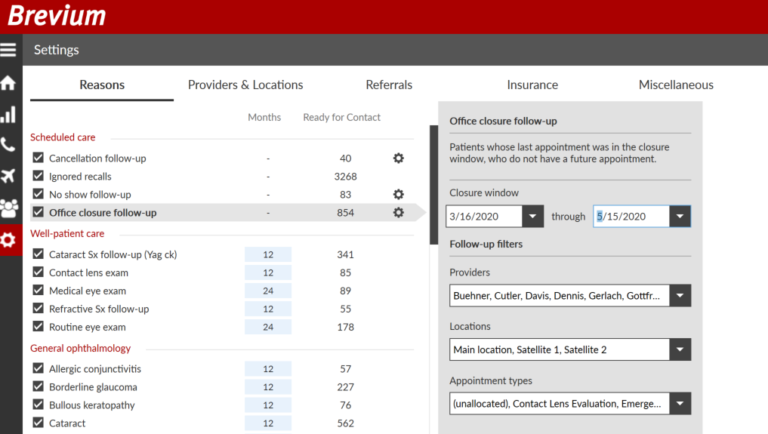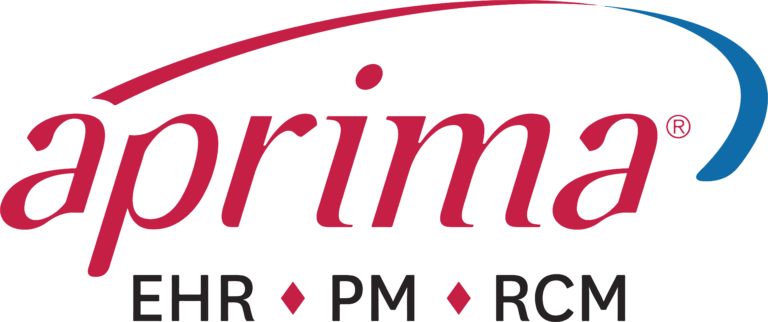The Brevium Blog

Metrics that Matter: Tracking Patient Reactivation Success
Losing patients is inevitable even for the most successful healthcare practices. Despite technological advancements that help healthcare organizations better store patient data and monitor treatment journeys, keeping track of every patient is impossible and patients sometimes slip through the cracks. Though most practices implement some form of patient reactivation to overcome this attrition, many practices fail to consider one critical step: measuring success through data analytics. Tracking key patient reactivation metrics is one of the best ways to know which aspects of your patient reactivation campaign are working and which areas might need improvement. Practices can track these metrics short-term, long-term or against specific criteria and ultimately, use the results to gain valuable insights that lead to informed decision-making—paving the way for the future growth and expansion of your practice. In this post, you’ll learn the key metrics for tracking patient reactivation success, best practices for improving these metrics, and tips for overcoming barriers preventing your healthcare organization from reaching its full potential.
Understanding Patient Reactivation
Patient reactivation campaigns are one of the most essential strategies for practices aiming to increase patient engagement and fuel organic practice growth. At this point, you may be wondering what patient reactivation is and why it’s so important for practices to implement these strategies into daily workflows. Simply, patient reactivation is the process of identifying overdue or lost patients who have become disengaged from their healthcare and employing strategic outreach to bring them back for treatment. Customer reactivation campaigns are vital for rekindling lost patient relationships and motivating inactive patients to become proactive participants in their own healthcare. There are many reasons practices may want to start patient reactivation campaigns, but most can be narrowed down to three main goals:
- Generating Practice Growth and Revenue
Practices often fail to realize the value that reactivated patients bring back to the practice. When practices implement effective patient reactivation strategies, they can expect to see significant returns, both in increased appointment volume and generated revenue. Many patients will require more than one appointment to address their needs, leading to more follow-ups, treatments, and in some cases, procedures and surgeries—ultimately resulting in full provider schedules and significantly boosted revenue. Further, practices see an improved ROI when implementing patient reactivation into their marketing strategies because of the low cost associated with bringing them back; in fact; it costs at least five times more to acquire new patients than to reactivate old ones—meaning your practices will see more revenue while spending less on engagement efforts.
- Enhancing Patient Care and Compliance
Most practices’ mission statements boast patient-centric treatment plans that help them deliver on their highest priority goal: enhancing patient health outcomes. Patient reactivation benefits the patient just as much as the practice by encouraging them to become active participants in their healthcare. Prioritizing patient reactivation helps your patients not only receive regular care that will boost their quality of life, but also keeps them compliant with preventative treatment that will reduce the risk of chronic disease or disability.
- Improving Patient Satisfaction
Effective patient reactivation empowers your patients to stay consistent with their healthcare; after all, practices who provide high-quality, timely care for their patients are providing a better treatment experience and environment than those who let patients remain lost. Showing that you remember them and care for their well-being fosters continued loyalty and satisfaction, making them more likely to return to you for any needed treatment. Plus, improved patient satisfaction often leads to increased practice growth, with satisfied customers being more likely to recommend your services to others.
Key Metrics for Tracking Patient Reactivation Success
Successful patient reactivation doesn’t just require practices to correctly identify and perform strategic outreach to re-engage lost patients, but also requires continual monitoring so your practice knows what works and what doesn’t. These metrics allow practices to accurately monitor their progress and arms them with the knowledge to make empowered decisions for optimizing reactivation workflows and achieving favorable results. There are three main categories for tracking patient reactivation success:
Patient Engagement Metrics
Patient engagement metrics provide valuable insight into the effectiveness of your outreach efforts and overall engagement strategy. Tracking these metrics revolves around how you engage your patients, which patients you engage and the success of that outreach. If your practice isn’t seeing desired results in other categories such as patient health outcomes or financial results, your patient engagement data should be the first place you check for flaws in the system. There are six main patient engagement metrics every practice should track as part of their reactivation campaign:
- Contacts sent – frequency of contacts sent to inactive patients.
- Communication channels – communication methods used to reach inactive patients (i.e. phone calls, autocalls, text/SMS, email, or postcard).
- Patient Type – patients you are targeting for reactivation. Many practices engage solely based on last treatment date; however, Brevium allows practices to segment their patients based on disease state, ICD-10 codes, CPT codes, provider, no-show/cancellation, and more.
- Appointments scheduled – number of appointments scheduled by inactive patients.
- Appointments kept – number of appointments attended or kept from your inactive patients.
- Patient conversion rate – the percentage of patients reactivated compared to contacts sent.
Health Outcome Metrics
Monitoring your patients’ health outcomes is just as important as any other metric; after all, the goal for reactivating overdue patients is to keep them compliant with treatment that will improve their quality of life and boost longevity. There are many different health outcome indicators practices can track to measure success, but the following are best used to evaluate the effectiveness of your patient reactivation strategy in enhancing patient health outcomes:
- Timeliness of care – how soon your inactive patients can get on the schedule.
- Follow-up care after initial reactivation – visit frequency after initial reactivation. Are your patients staying compliant with care after you reactivate them?
- Conversion rate for high-risk patients – number of high-risk patients reactivated compared to contacts sent.
- Surgeries/procedures as result of reactivation – number of patients who go on to receive essential surgeries or procedures due to your reactivation efforts.
Financial Metrics
Running a successful healthcare practice is the same as any other business that sells goods: you offer high-quality services or products and implement a marketing strategy to both attract new patients and retain customers. Tracking key financial metrics is an essential step in your patient reactivation campaign as these numbers provide a greater understanding of your overall strategy and the success of your practice in reaching its goals; however, failing to track the right financial metrics can hinder growth goals and cause your progress to remain stagnant. The following are key financial performance indicators your practice should monitor to better understand the effectiveness of your patient reactivation campaign:
- ROI of reactivation campaigns – performance indicator tracking your return based on your investment (i.e. money, time, effort). Measures how much money your practice makes from reactivated patients compared to the amount spent to reactivate them.
- Revenue generated from reactivated patients – revenue generated solely from your reactivated patients’ visits and procedures.
- Cost per reactivated patient – average cost to reactivate each patient.
Using Patient Reactivation Software to Track Metrics
Getting started with patient reactivation can be a hassle for many practices trying to do the process manually. Most practices have the raw data at their fingertips within their practice management systems (PM), yet many don’t have efficient processes in place to gather, organize and understand this data that would enable them to gain meaningful insights. Further, healthcare data is constantly evolving, and most practices don’t have the manpower to efficiently stay on top of tracking these important metrics.
Luckily, the healthcare technology industry has boomed in recent years and practices now have more say than ever in the software they use to improve productivity, gain insights and enhance the overall quality of patient care. There are various patient engagement software that claim to do patient reactivation; however, not all technology is created equal. Brevium is the pioneer and leader in patient reactivation technology, utilizing a patented approach to boost practices’ patient reactivation and retention rates. One of the many unique features of Brevium’s software is its advanced reporting tools that use in-depth practice data to provide immediate insights into the effectiveness of your patient reactivation efforts. And not only is the data always accurate because of the software’s consistent updates, but the information is also stored in one place, making it easily accessible for your staff to monitor progress without sacrificing valuable time. Here are the key features of Brevium’s reporting tools:
- Brevium Dashboard: Shows you the status of your patient reactivation, including the number of patients in your database ready for contact, number of patients contacted so far, appointments scheduled, revenue generated, and overall ROI. This information is easily accessible and can be exported at any time to be used in emails or financial reports.
- Detailed Reporting: Brevium can report on anything it does to find and reactivate your patients. The software’s in-depth reporting allows you to see and analyze any step of the patient reactivation process including patients ready for reactivation, contact attempts, appointments scheduled, appointments kept, patient conversion rate, and more. These reports also measure financial success, providing valuable insight on revenue generated, cost per reactivated patient and overall ROI. Essentially, Brevium enables practices to customize their reports and track different parts of their patient reactivation campaigns to ensure optimal results.
- Provider Busyness Report: Brevium’s medical scheduling software that links with your PM to analyze and track individual provider schedules. This report tracks several factors: weekly appointment volume by provider, new patient ratio, no-show rates, overbooking statistics, appointments per hour, and average time between scheduling and appointment. All these data points eventually factor into a ‘busyness score’ that each provider is assigned when the report is generated. This report helps practices optimize their provider scheduling to better accommodate their reactivated patients.
Best Practices for Improving Patient Reactivation Metrics
While most practices do patient reactivation in some form, many do not employ effective contact strategies, often resulting in failed reactivation attempts and dead ends. Successful patient reactivation goes beyond generic recalls, requiring practices to implement effective strategies and techniques that will truly re-engage their patients in a way that benefits both patient and practice alike. We’ve already discussed the importance of using key metrics to measure your success and how implementing a software would streamline a usually tedious reactivation process. The following are additional strategies your practice can utilize to further improve patient reactivation metrics:
Patient Segmentation
Rather than sending generic outreach to any and every inactive patient, practices should tailor their reactivation approaches according to their goals. Is your goal to reactivate patients who no-showed or canceled appointments and never rescheduled? Maybe those with higher-risk diagnoses? Or perhaps patients who are more likely to need procedures or surgeries? After identifying patients ready for reactivation and segmenting them into distinct groups, practices can choose who to target first based on provider availability and practice goals. Though this step can be done manually, the process is often tedious and poses a high risk for staff error. Instead, consider using a software to streamline the process by letting it identify your inactive patients and segment them for you. Brevium’s patented patient reactivation technology does this process and more by integrating with your PM and mining the database for overdue patients using unique patient identifiers, including but not limited to: ICD-10 and CPT codes, appointment history, insurance coverage, provider, practice location, and more.
Personalized Patient Communication
According to CVS’ 2022 Health Care Insights Study, patients are now beginning to value more meaningful relationships with their providers and believe the current healthcare system prevents them from receiving this kind of care; in fact, 85 percent of consumers polled believe personalized healthcare is important. Sending mass communications is no longer enough to satisfy today’s patient. Rather, practices should consider the best way to personalize communication to meet patients where they are. Reviving the conversation using your inactive patients’ preferred communication channels and personalizing the messages to include relevant, patient-specific information are two of many ways practices can provide customized care and optimize communication. Plus, a 2021 McKinsey and Company report found that practices who implement patient personalization generate over 40 percent more in revenue than those who do not—meaning personalized healthcare and communication doesn’t just benefit your patients but also drives growth for your practice. Personalized patient communication is more important than ever for not only empowering your inactive patients to act on the belief they can change their health outcomes through recommended treatment, but for also boosting reactivation rates and seeing a greater return on investment.
Multichannel Communication with Repeat Contact Attempts
Brevium’s 2019 ALOHA Study analyzed strategies and factors that drive lost, overdue, high-risk and absentee patients to return for care. Here’s what they found:
- Contact Attempts: Contacting your inactive patients four to five times over an extended period increased patient reactivation rates by 81 percent. Brevium concludes that practices who make at least six contact attempts per inactive patient will see the best results.
- Varied Outreach Methods: Practices are most successful with patient reactivation when using multiple contact methods to reach their overdue patients. Brevium found that using just three outreach methods reaches more than 95 percent of a practice’s inactive patients.
- Reachability: Not all contact methods have the same effectiveness which is why they are most successfully used in tandem. The contact channels with the highest conversion rates correspond with the method’s reachability—meaning patients are reachable through these channels. The following contact methods are listed from most to least effective: staff calls, postcards, autocalls, emails and texts.
The results are undeniable: Practices significantly boost customer reactivation rates when contacting patients 1) multiple times, 2) through multiple communication channels, and 3) over an extended period. Implementing these proven strategies will return inactive patients to your practice at much higher rates—ultimately resulting in greater patient compliance, increased business and boosted revenue.
Overcoming Common Challenges in Tracking Patient Reactivation Metrics
Integrating insights from data analysis into your healthcare organization’s reactivation campaign can bring about great benefits for both practice and patient; however, data analytics can be a major process that often requires practices to closely examine their approach to gathering, storing and analyzing information. Here are a few common challenges practices face when attempting to track and measure patient reactivation success:
Data Accuracy
One of the biggest hurdles to effective patient reactivation is ensuring you have the correct information to reactivate patients. There are many reasons your data might be failing you:
- Switched PM & lost access to vital patient data, such as treatment history, billing history, disease profile, and more.
- Patient information needs updating.
- Staff error inputting patient information.
Luckily, Brevium offers solutions for these challenges. As a result of the previously mentioned ALOHA Study, Brevium found that practices could reach 95 percent of its inactive patients when using at least three different contact methods in their outreach strategy. However, many practices only use one form of generic outreach to contact their reactivated patients which significantly limits their reactivation potential if that one communication channel is either incorrect or inconvenient for the patient. Unless your practice opts for live staff calls, Brevium will employ solely automated contact attempts as part of its programmed reactivation strategy—ensuring your patients are reached by methods they are likely to respond to. Brevium also uses its Stitch feature to help practices who have lost priceless patient data in transition between PM. By merging the old PM with the new, Brevium matches patients, providers and locations across systems, creating a seamless file of patient history that is imperative for successful patient reactivation.
Resource Constraints and Budget Limitations
There are three common barriers that prevent practices from effectively tracking their patient reactivation success: scope, time and money. It’s almost a given that at some point in your reactivation campaign, you’ll run into one of these challenges that can negatively affect the overall quality of your project and strategy. With the question not being if these problems will arise but when, your practice will need to be equipped with the right tools to successfully navigate these limitations.
The absolute best tool for overcoming these constraints is patient reactivation software. Technology like Brevium addresses limitations such as lack of staff time, manpower and energy by completely automating the reactivation process—including the way it tracks important metrics. After the practice sets the parameters for which patients they want contacted and the channels for reaching them, Brevium runs in the background and performs patient reactivation without your staff needing to lift a finger. During this process, the software constantly gathers and stores data from its reactivation efforts that can instantly be generated into detailed, in-depth reports. As for the cost, Brevium addresses financial concerns with one simple fact: Brevium does not get paid unless the software does its job. Though the average customer makes $25 for every dollar paid to Brevium, customers consistently justify the cost by reporting that the patented software has reactivated more patients than any process or technology used before. After accounting for the saved time, energy and money that could be put toward other aspects of running a successful practice, implementing patient reactivation software to not only automate your entire patient reactivation process, but also provide meaningful insight from your data, is a no-brainer.
Conclusion
Tracking patient reactivation metrics is not just a recommendation, but an essential component for the success of your reactivation campaign. However, capturing the data is only the first step. Practices need the ability to make sense of their data by identifying patterns and correlations, spotting abnormalities, and finding meaning within the data to generate actionable insights. This insight that your personalized, in-depth practice data provides is invaluable for optimizing patient health outcomes and improving financial performance. Though tracking these metrics can prove to be a difficult task when paired with other responsibilities, the process is made infinitely easier with modern solutions—namely Brevium’s patented patient reactivation software that automates the entire patient reactivation process and uses advanced reporting tools to track important metrics in real-time. Contact us to learn more about how Brevium’s software can address your unique patient reactivation goals to drive better patient health outcomes and maximize financial returns.














